Starting Tactics With Nick Craig
Book Extract
Being able to start consistently well in big fleets is a key skill for delivering a consistent series.
Starting is a process, albeit a relatively complex one. Like any process it can be perfected if each part of it is well practised. So it is easier to perfect starting than picking shifts or sailing fast downwind, which are more of an art rather than a process.
Conversely, starts are less important in smaller fleets and shiftier winds so the ability to start consistently well is a key factor in the transition from a leading club racer to championship contender.
SLOW SPEED BOAT HANDLING
Slow speed boat handling is the foundation for strong starting. It is a distinct skill; sailors can be fantastic at normal speed boat handling and many aspects of the sport but still weak at slow speed boat handling. However, it is an area few sailors practise.
Boats behave very differently at fast and slow speeds. At slow speeds, the foils start to stall or are completely stalling so that your boat becomes a very different and tricky beast. So practising controlling your boat at slow speeds is key to starting consistently well.
Being able to handle your boat effectively at slow speeds will enable you to generate space quickly on a start line, thus reducing the time available for anyone else to fill that critical space.
Stalling Foils
As your boat slows, the flow over your foils will eventually stall. Your boat then behaves totally differently.
Starting well is hard because everyone is sailing slowly with potentially stalling foils and boats which are difficult to handle. This is how start line pile-ups arise!
The key is to practise sailing your boat with both stalled foils and foils on the edge of stalling. You need to learn where that knife-edge of stalling foils is for your boat in all conditions.
You should aim to be able to stay on that knife-edge of stalling foils more effectively than your competition. By doing that, you can crucially creep towards the line more slowly than other boats in the last minute before the start and in control. This gives you more space to accelerate and more options.
You should also practise generating a gap to leeward as quickly as possible. This is achieved by being able to sail your boat up to head to wind and even slightly beyond head to wind, without losing control. While you have no rights if you point beyond head to wind, you can briefly do this to gain more space to leeward so long as you don’t infringe other boats. So being able to steer some big angles and manage that with aggressive but legal rudder use, heel and sail trim is a key skill. The precise combination of these three weapons (rudder, heel and sail trim) that is most effective varies by boat but can be learnt with practice.
In general, leeward heel will help keep your foils biting longer. In lighter winds, this generally means standing up rather than sitting comfortably on the sidedeck digesting your breakfast!
You should practise controlling your boat with stalled foils. So then, if you do slow down to the point that your foils stall, by accident or design, you can remain in control.
Exercises
An effective exercise for learning about your boat’s stalling foils is to stop by a mark and aim to stay within around a boat’s length of it for two minutes. You should vary that boat length gap depending on how easy your boat is to handle at low speeds, the wind strength and how experienced you are at this.
As part of that exercise, you should aim to be at as near to full speed as you can by the mark on the ‘start gun’. Being able to bring your boat up to speed, known as ‘pulling the trigger’, in as short space of time and distance as possible is a critical skill in a crowded start.
This isn’t the most exciting exercise, so trying this little but often works well to stave off boredom. Do this two or three times before racing every time you sail and you will quickly develop great slowspeed boat handling skills. You should line up next to the buoy at different angles to simulate both a starboard and port biased start line.
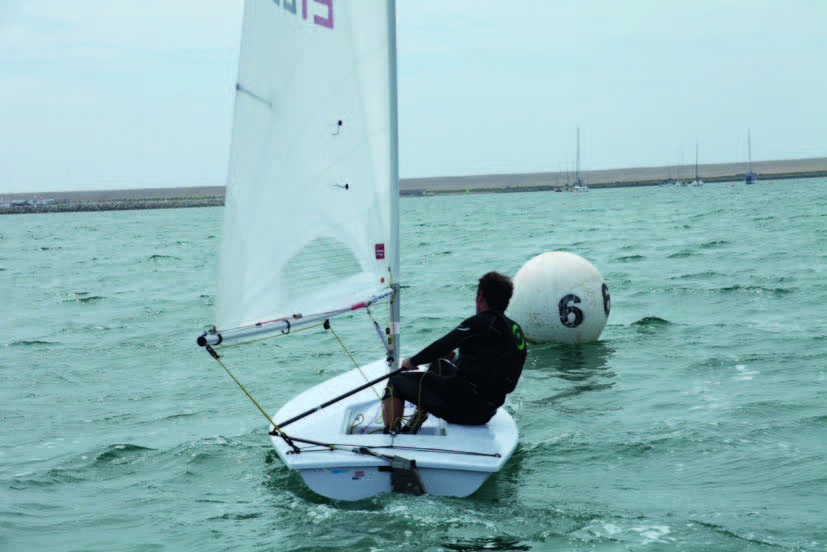
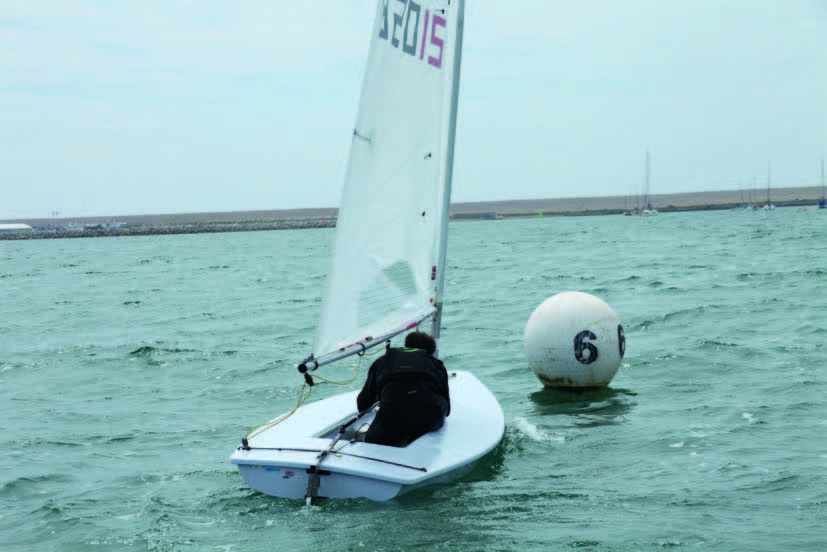
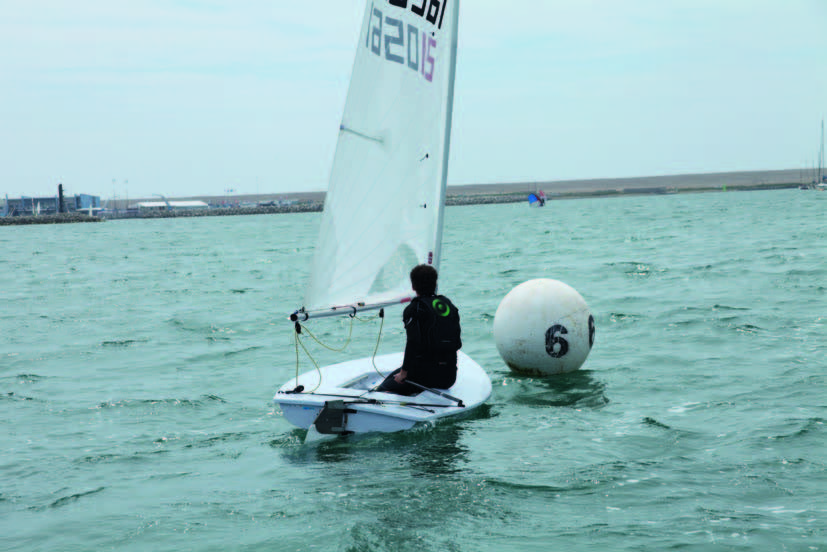
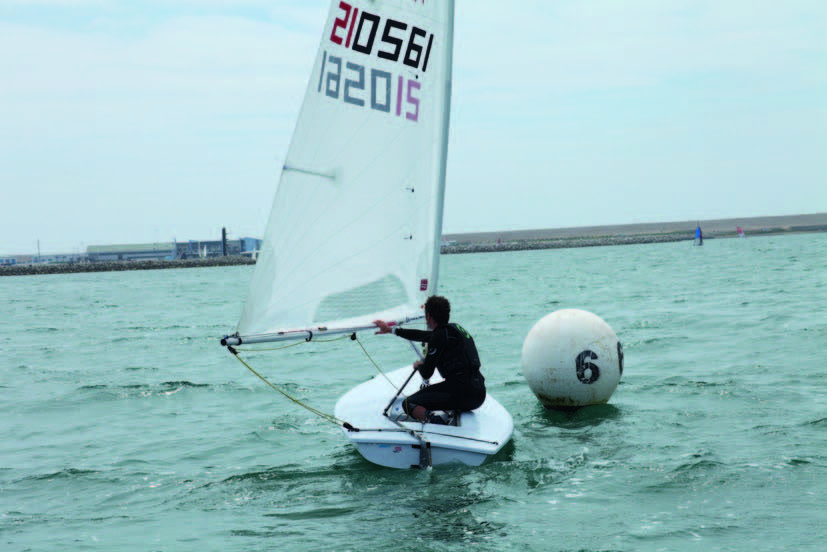
Practise staying by a mark for 2 minutes
THE START PROCESS
1 Hour to 10 Minutes Pre-start
This is a key time because your information gathering during this period will determine your chances of getting the first beat right.
However, it is absolutely OK, and pretty common, not to know which way will pay up the first beat. Be honest with yourself about this as a rash decision that one way is favoured means that you are taking uncalculated risks which typically racks up points over a week.
If you are unsure, sail up the middle of the course relative to the fleet.
Your starting strategy is closely linked to your first beat plan so this information is doubly important. The table shows the 9 start scenarios:
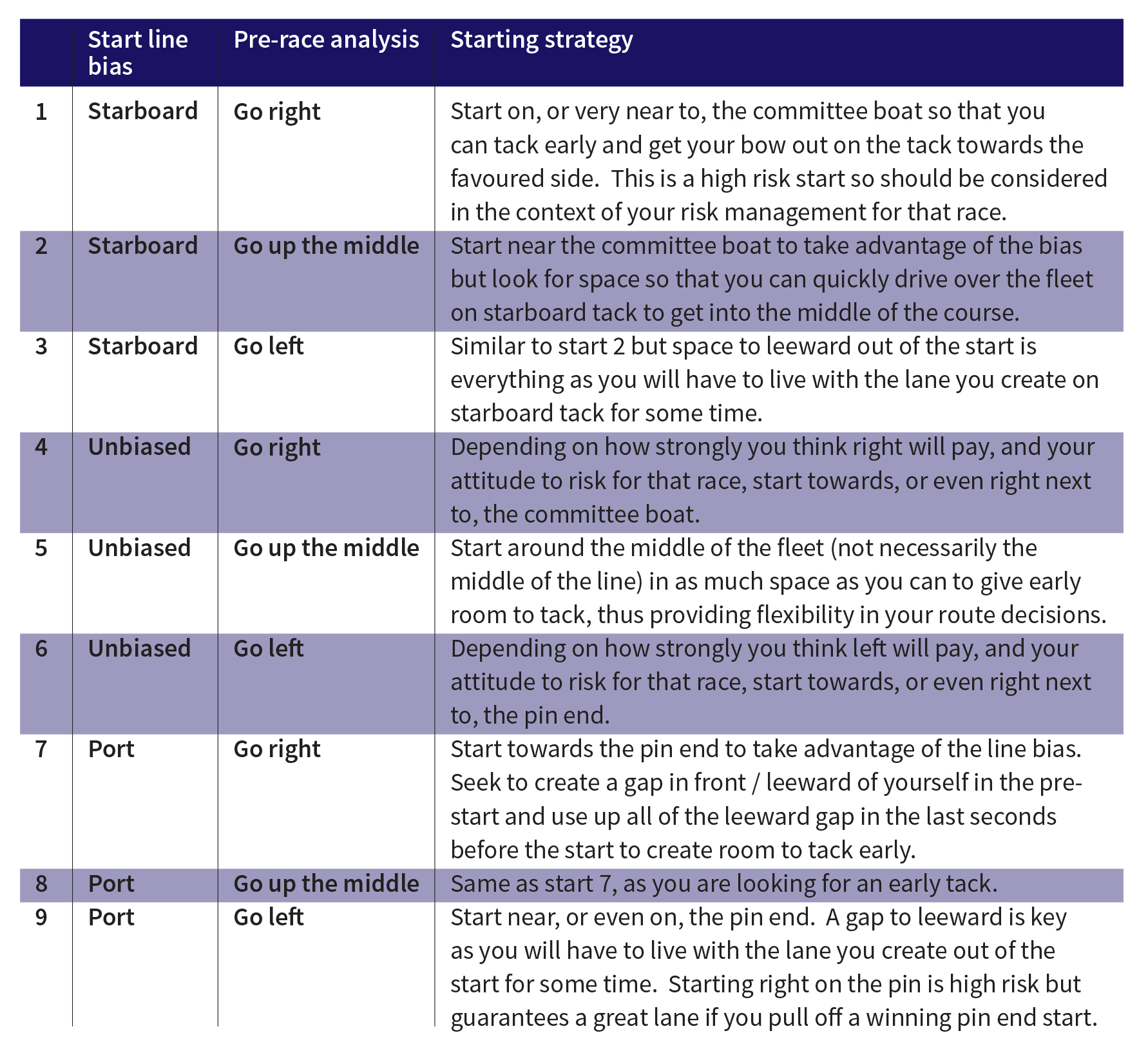
You should overlay your attitude to risk for that race on your starting strategy, backing away from the ends or crowds if you are looking for a low-risk race. Starting at the ends is especially high risk because, if it all goes wrong, you may hit the committee boat or pin end or miss the line, whereas the cost of a poor start away from the ends is usually less.
You should also know your boat and your capability in it. Some boats are harder to handle in tight situations (e.g. skiffs). Quality pre-start boat handling requires practice. So if you are new to a boat, or rusty, you may back-off from tight spots at main events (but not training events!). If you are well practised in the boat you are sailing, you can be punchier with your starting plan.
In very light winds, it often pays to start at the ends, especially in big fleets. The wind has little energy so dirty air and the deflection of wind as it passes over the fleet is bigger, making the ends better places to start.

In light winds, it often pays to start at the ends in big fleets
You need to practise all these types of starts in your training events so you become 100% comfortable with every type of start in all situations (light winds, windy, tidal etc.). This is a key set of skills to enable big fleet consistency so you can deliver great starts in all situations rather than the occasional great start and then weaker starts in your unfavoured scenarios which leads to inconsistent results.
You will know which of these starting types you relish and which you approach with slight trepidation. You should put yourself out your comfort zone at training events, challenging yourself to pull off great starts in your weaker areas. Also start in the pack at training events to improve your ability to pull off the really tough starts. It is rare that there is lots of space in a big fleet start so, by pushing yourself to start in the pack at smaller events, you can simulate big fleet starts all year round rather than just a few times a year. This will massively accelerate your learning curve.
10 Minutes to 5 Minutes Pre-start
Once you have gathered all your information about the race track for the day, it is time to check transits and line bias. Whilst doing this, you should remain aware of anything that may change your first beat plan, especially the windshift and gust pattern. So keep your head out the boat and looking up the race course whilst performing these transits and line bias checks.
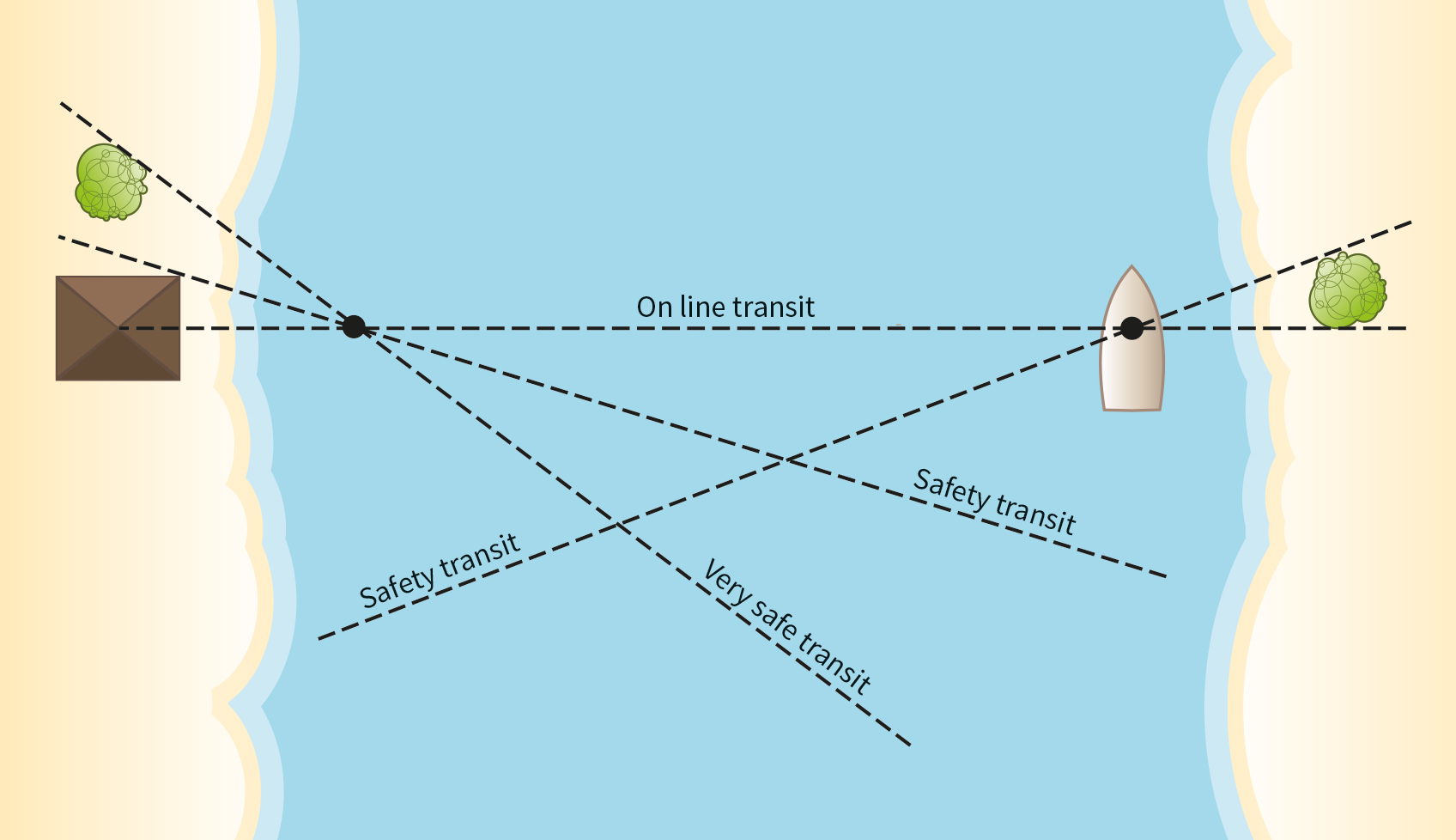
Getting transits
It is rare that there is a perfect transit on the shore in line with the start line. If there isn’t, this should not be a concern. You should aim to have two or three 3 transits at either end of the line: ideally, one for when you are over the line, one on and one behind. And, if you can, develop a picture of what you see in between them. This typically means having a look down the line several times so you can form a map of the start line geography in your head, at both ends if possible. In the reality of the last seconds before the start on a crowded start line, it is rare that you will find you’re on a line transit, but just a glimpse of what you can recall on the landscape can give you the confidence to take a crucial jump on the fleet.
If there are no transits this is, in many ways, a great opportunity for a flying start! No one else will have a transit so there is typically a lot of line sag. This presents the chance to make a jump on the fleet away from the ends if that fits with your first beat plan. There is typically more line sag on longer start lines, lower quality fleets and where there is more adverse tide and wind or waves. So be comfortable taking a jump on the fleet if those factors are in play.
5 Minutes to 1 Minute (or sooner depending on the boat) Pre-start
During this period, you should still very much keep your head out the boat and be aware of any changes in wind across the course or signs of change from the clouds. Consider the impact of any changes on your starting plans both in terms of line bias and which way may pay up the first beat.
As you move towards a minute (or sooner with a densely-populated start line), you should find space in the area that you would like to start. You should remain flexible. For example, if the line is starboard biased but you want a low-risk start, this generally means starting away from the committee boat. However, if everyone is doing that, there is sometimes lots of room at the committee boat. That often happens early in a series when most boats are looking to de-risk their starts.
Starting in as much space as possible reduces the damage of a sub-standard start. With fewer boats around you, there is much more likely to be room to tack or sail free and find a lane than if you are starting in a pack.
Choosing who you line up near is very important. Ideally you should line up near boats that you know you can outpace. However, you should avoid lining up next to someone who might be out of control. Whilst an out-of-control boat may be penalised with a 720⁰ penalty, an incident just before the start can ruin your start no matter how right you are!
Starting next to an in-control, but slower, boat gives you a strong chance of gaining a crucial early lane and also starting worry free. By the same token, it is very powerful to gain a reputation for being fast and difficult to start near (so others avoid starting near you). This is worth cultivating at training events.
The Final Minute Pre-start
You should be seeking to line up bow down of the boats around you i.e. further back from the start line than the boats around you with your bow just overlapped with the front row to keep your ‘starting slot’.

Ideally position yourself slightly further back from the boats around you with 30 seconds to go
By lining up down versus other boats, you are highly unlikely to be black flagged or put your sail number in the race officer’s head. Lining up bow down also means that you have more space to accelerate into before hitting the start line than the boats around you. So you can sheet in before everyone else and hit the start line with more speed. Also, lining up bow down means that you don’t reveal where your transits are.
On a port-biased line, when you sheet in on starboard you make less distance towards the line than on a starboard-biased line. So you can typically sheet in earlier on a port-biased start line.
You should reveal your transit as late as possible. So, ideally, you should sheet in and accelerate once and not have to slow down again, whilst using up every inch of your transit. Not easy! Judging time and distance is key for this. Spending some time pre-start understanding your speed of travel versus your transits can be a helpful exercise, especially in tide.
Lining up bow down is potentially a risky starting strategy because, if you don’t sheet in before the boats around you, they will roll you.
The key to making this work is confidence in your transits and the time and distance it takes to reach those transits. If you are 100% confident in both, anyone who sheets in before you will be OCS so it is unlikely that anyone will do that. If you are not fully confident in your transits or time and distance to the start line, you should de-risk by lining up further forward on the boats around you.

If you aren’t 100% confident in your transits, line up further forward
You should create space to leeward as late as possible to reduce the risk of the lovely gap that you have hopefully created being filled by a latecomer. Being able to create that gap quickly is a key benefit of practising your slow speed boat handling.
With a starboard-biased start line, you are looking for a gap to leeward as it is going to take some time to get your bow forward on your opposition so that you have enough room to tack. You are going to have to live with the lane you created pre-start for some time, so a gap to leeward is important.
In lighter winds, you should aim to create a bigger gap to leeward as acceleration from near stationary to full speed takes longer.
In the last minute, you need to be highly aware of boats potentially coming in and filling your gap to leeward. In a 2-man boat, the helm should be more visually focused to leeward as a fast reaction is needed to stop a boat filling your gap to leeward. The crew should then be more focused on looking to windward for transits and cover.
To prevent someone filling your lovely leeward gap, you need to temporarily fill the gap before they arrive. This will generally deter the gap filler and they will sail along the line and seek an easier gap. You should fill the gap by bearing off hard so that your boat spins 90⁰ which fills the gap more effectively. You should bear off ‘badly’ such that you move forward as little as possible so not losing too much of your gap to leeward. A bad bear off uses lots of rudder to slow you down. To do this, use heel and sail trim to fight the turn so you need to use more rudder to turn (i.e. leeward heel and main sheeted in and jib eased as you bear off). As soon as the boat potentially filling your gap has headed on their way, you should luff back up hard and use the momentum from your bear off to claw back some distance to windward so re-creating your gap to leeward. All of these moves are difficult and need practice in training time.
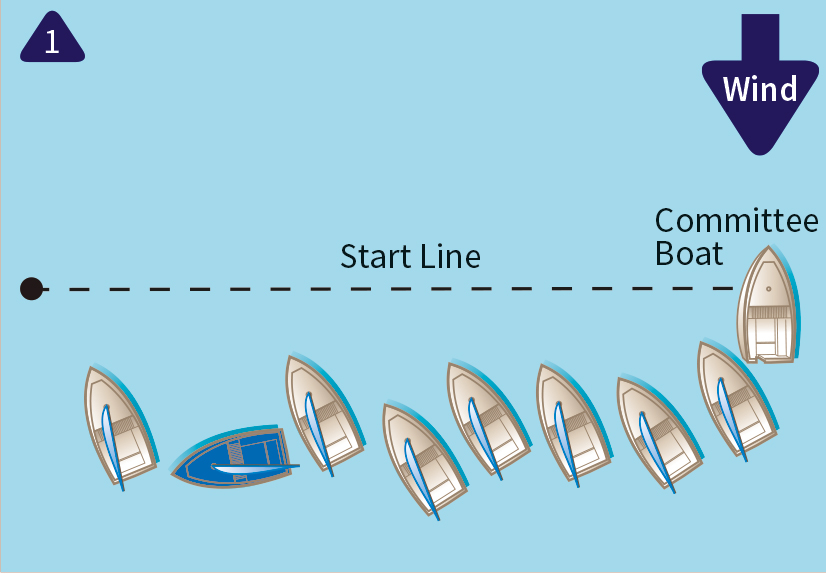
To protect your leeward gap, bear away sharply
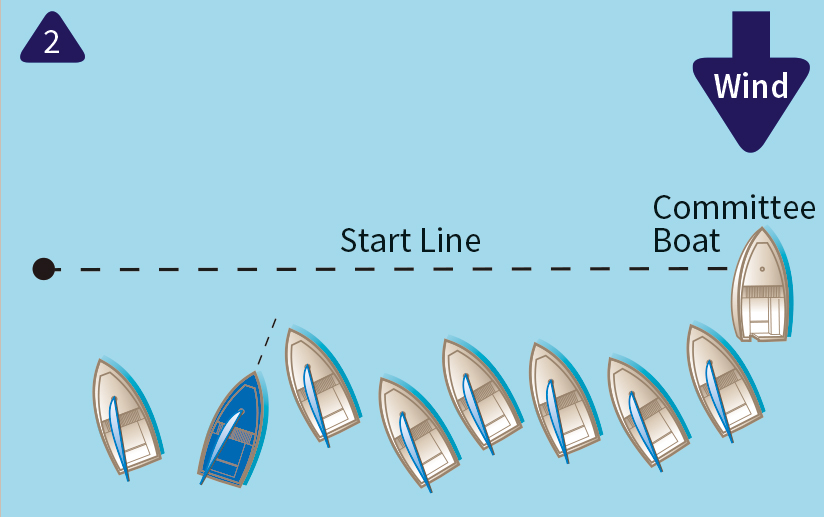
And then luff up hard to claw back some distance to windward
If you find yourself in a pile-up, or even just a crowd, from which a good start looks challenging, be quick to escape and find space if you see there is more space elsewhere.
With a port-biased start line, you are generally looking to tack early to consolidate a hopefully strong start. To do this, a gap to windward is needed. So create a gap to leeward in the prestart period and then sheet in really early to use up that gap and create a gap to windward on the starting signal. This gives you the room to tack early. If you don’t envisage that you will be able to tack quickly, you also need to leave some gap to leeward so you can maintain a lane out the start. This is a very hard start to pull off, but potentially very rewarding as not many boats will manage it. If you can make room to be one of the first to tack out, you are probably laughing your way to at least a top 5 placing at the windward mark!
You should review how often you are OCS. If this is rare, especially at training events, you should be pushing your starts harder.
As you accelerate for the start, in order to ideally hit the line at full speed on the start gun, ensure that you use heel and sail trim to accelerate. This will maximise acceleration and hopefully give an edge on the boats around you. Your bear off to accelerate should be initiated with windward heel and early jib trim. You should then straighten your course and then luff with leeward heel and fast main trimming.
There is a lot going on during this last minute but you also need to keep your head out the boat and stay observant, especially in shifty unstable breezes. You may need to change your plan quickly and move up or down the line if you see new pressure or a shift coming. This is a key role of a top crew.
The First Minute Post-start
Gains in the first minute of the race are massively magnified as you move through the race as the early leaders benefit from clear air, clear water and control of their race plan. So hiking at your absolute hardest as soon as there is wind on for at least the first minute, or until you poke your bow out from the pack, is very rewarding. Sprint hiking and trimming hard for 10 seconds can work to nudge your nose out. Sprint hiking is when you hike to your absolute maximum for a burst and then rest up a little to let the blood flow back through your legs. In light winds, all the smooth steering and movement you have practised (see Helming to Win) should give you the confidence to relax and sail fast.
In this first minute, you should drive home your first beat strategy:
- If your plan is to go left then, if there is space, sail a little lower on starboard than usual.
- If you are unsure which way will pay and find you are to the left of the fleet, sail a bit higher or tack on the next small shift or gap.
- If you are looking to head right, you should tack early or proactively find a lane to tack by sailing high to force the boats above you to tack, or if your start was not so good, look for a gap to tack and duck transoms.
You should sail high or low using your rig set-up and heel rather than pulling on your rudder too much:
- To sail high: a touch of leeward heel, more sheet tension and kicker, draft back on sails. Consistency of heel maintains flow over your foils so, if you do need to sail with heel, aim to keep the amount of heel stable. Leeward heel adds bite to your foils so you are less likely to slip sideways which can be very helpful – for example, if you are trying to live in a leebow situation where you might be pinching and therefore slowed, giving an increased risk of slipping sideways.
- To sail low: dead flat, more forgiving leeches and draft forward.
You should weigh up making these potential adjustments versus the distance lost whilst making them. Adjusting heel and sheet tension is easy and generally loses no distance. Adjusting kicker and draft may take more time and lose distance if you have to move in from hiking or lose precision of steering to make the adjustments. You should work on being able to make adjustments with minimal distance loss. A top crew can make these adjustments whilst the helm keeps their head out the boat and in rhythm with the windshifts – Alan Roberts is outstanding at this in a Merlin.
You should always stay positive about a poor start line as they present a great opportunity! A biased, short and congested start line means that only a few boats will get a decent start. Make sure you are one of them!
© Not to be reproduced without written permission from Fernhurst Books Limited.
Multi-champion Nick Craig is author of the amazing book Tactics to Win which gives you some understanding of why he’s won so many championships.